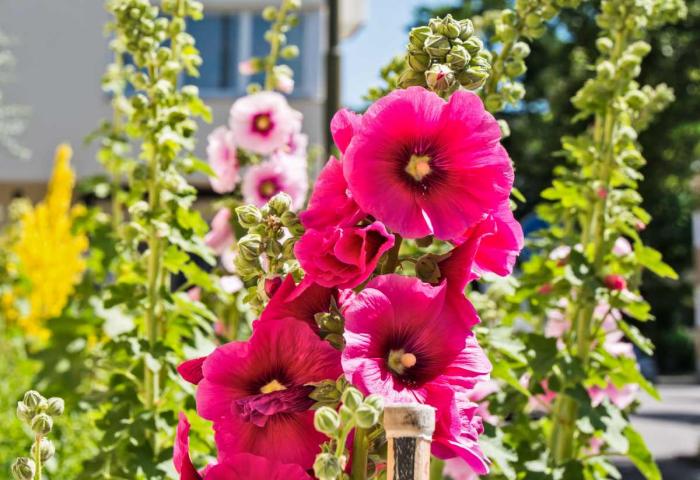Hydrangeas are a beloved choice for gardeners, known for their stunning blooms and variety. Among the many types of hydrangeas, mophead varieties stand out with their full, round heads packed with large petals. In contrast, lacecap hydrangeas feature a unique design, showcasing tiny flowers at the center surrounded by a halo of larger petals. While these beautiful plants can brighten any garden, proper care and maintenance are crucial for ensuring a vibrant display of flowers each year.
Expert Advice from Horticulturists
Jessica Walliser, an award-winning horticulturist and author of seven gardening books, recently shared valuable insights on pruning hydrangeas through her blog, Savvy Gardening. According to Walliser, the timing of pruning is vital to the health and vitality of these plants. She strongly advises against pruning hydrangeas in the autumn months, emphasizing that this timing can have detrimental effects on the flowering process.
“Whether you are growing gorgeous panicle hydrangeas or classic mophead hydrangeas, pruning should never be done in autumn,” Walliser cautions. Pruning at this time can lead to disastrous consequences, including a significant reduction in blooms for the following season.
The Risks of Autumn Pruning
The warning from Walliser highlights a common misconception among gardeners: that pruning can be beneficial at any time of the year. However, autumn pruning can actually expose hydrangeas to frost damage. By cutting back the stems too early, gardeners risk eliminating potential flower buds that need time to develop during the winter months.
Walliser notes that while it is acceptable to snip off spent blooms from mophead hydrangeas in milder climates, it is generally best to let these blooms remain throughout the winter. The Royal Horticultural Society (RHS) supports this recommendation, stating that allowing the blooms to persist offers vital protection to the plant.
Optimal Pruning Practices
According to gardening experts, the “correct time” to prune most hydrangeas is during late winter or early spring. This timing allows gardeners to prepare the plants for new growth while ensuring that the fragile flower buds remain intact during the winter. Pruning during these periods helps to promote healthy blooms in the spring and summer months.
For climbing hydrangeas, a slightly different approach is required. These types of hydrangeas should be pruned after flowering, specifically in the summer. This strategy is essential because it protects the tender growth buds that are nestled beneath the foliage, shielding them from the cold and ensuring a strong return in the warmer seasons.
Step-by-Step Pruning Guide
To achieve the best results when pruning hydrangeas, Walliser and the RHS recommend following specific guidelines. First, dead flower heads should be removed in early spring. Gardeners are advised to cut back the stem to the first strong, healthy pair of buds below the faded bloom. This practice not only encourages robust growth but also helps to maintain the overall shape and aesthetics of the plant.
When pruning mophead hydrangeas, it’s crucial to recognize that these plants bloom on old wood. As a result, removing too much of the plant can lead to a lack of blooms in the following year. For this reason, pruning should be approached with care and precision.
Seasonal Considerations for Pruning
Gardening practices vary significantly depending on regional climates, which can influence the timing of pruning. In areas with milder winters, it may be possible to prune slightly earlier in the spring, while in regions with harsh winters, it is essential to wait until the threat of frost has passed. Understanding local weather patterns can help gardeners make informed decisions about when to prune their hydrangeas.
Moreover, soil conditions and moisture levels can also play a significant role in determining the optimal time for pruning. For instance, if the ground is still frozen or overly saturated, it may be best to postpone pruning until conditions improve.
Maintaining Hydrangea Health Year-Round
In addition to proper pruning techniques, maintaining hydrangeas involves regular care throughout the year. Ensuring that these plants receive adequate water, especially during dry spells, is vital for their overall health. Hydrangeas thrive in moist, well-drained soil, so gardeners should monitor moisture levels and water accordingly.
Fertilization is another important aspect of hydrangea care. Applying a balanced fertilizer in early spring can provide the necessary nutrients for robust growth and vibrant blooms. However, gardeners should avoid over-fertilizing, as this can lead to excessive foliage growth at the expense of flowers.
Common Mistakes to Avoid
While pruning hydrangeas is essential for promoting healthy blooms, several common mistakes can hinder a gardener’s success. One of the most frequent errors is not understanding the specific type of hydrangea being cultivated. Each variety has unique pruning requirements, and failing to recognize these differences can result in missed opportunities for beautiful blooms.
Additionally, many gardeners are prone to the habit of pruning too late in the season. Waiting until summer to prune can risk removing buds that would otherwise produce flowers in the upcoming season. To avoid this, gardeners should familiarize themselves with the blooming habits of their specific hydrangea varieties and adhere to recommended pruning times.
Conclusion: Pruning for Success
In conclusion, proper pruning is essential for maintaining healthy hydrangeas and ensuring a flourishing display of blooms. By following expert advice from horticulturists like Jessica Walliser, gardeners can significantly enhance the vitality of their plants. Remembering the importance of timing—specifically avoiding autumn pruning and instead focusing on late winter or early spring—can make all the difference in achieving a bountiful garden.
As gardeners embrace the beauty and diversity of hydrangeas, they should also remain vigilant about the specific needs of their plants. With careful attention to pruning practices, seasonal care, and an understanding of hydrangea varieties, anyone can cultivate stunning hydrangea blooms year after year. By following these guidelines, the risk of “no blooms next year” can be mitigated, allowing gardeners to enjoy the full splendor of their hydrangea gardens.
Related topics:


